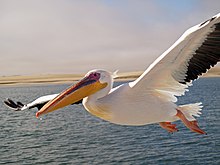Pelecanus
| Pelican Temporal range: Early Oligocene-Recent, 28.1–0 Ma |
|
|---|---|
 |
|
| A great white pelican in breeding condition flying over Walvis Bay, Namibia. | |
| Scientific classification | |
| Kingdom: | Animalia |
| Phylum: | Chordata |
| Class: | Aves |
| Order: | Pelecaniformes |
| Family: |
Pelecanidae Rafinesque, 1815 |
| Genus: |
Pelecanus Linnaeus, 1758 |
| Type species | |
|
Pelecanus onocrotalus Linnaeus, 1758 |
|
| Species | |
|
8, see text |
|
8, see text
Pelicans are a genus of large water birds that makes up the family Pelecanidae. They are characterised by a long beak and a large throat pouch used for catching prey and draining water from the scooped up contents before swallowing. They have predominantly pale plumage, the exceptions being the brown and Peruvian pelicans. The bills, pouches and bare facial skin of all species become brightly coloured before the breeding season. The eight living pelican species have a patchy global distribution, ranging latitudinally from the tropics to the temperate zone, though they are absent from interior South America as well as from polar regions and the open ocean.
Long thought to be related to frigatebirds, cormorants, tropicbirds, gannets and boobies, pelicans instead are now known to be most closely related to the shoebill and hamerkop, and are placed in the order Pelecaniformes. Ibises, spoonbills, herons and the desolate bitterns have been classified in the same order. Fossil evidence of pelicans dates back to at least 30 million years to the remains of a beak very similar to that of modern species recovered from Oligocene strata in France. They are thought to have evolved in the Old World and spread into the Americas; this is reflected in the relationships within the genus as the eight species divide into Old World and New World lineages.
...
Wikipedia
